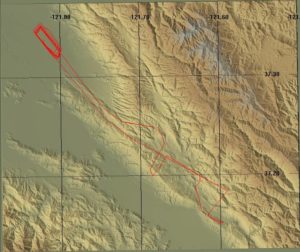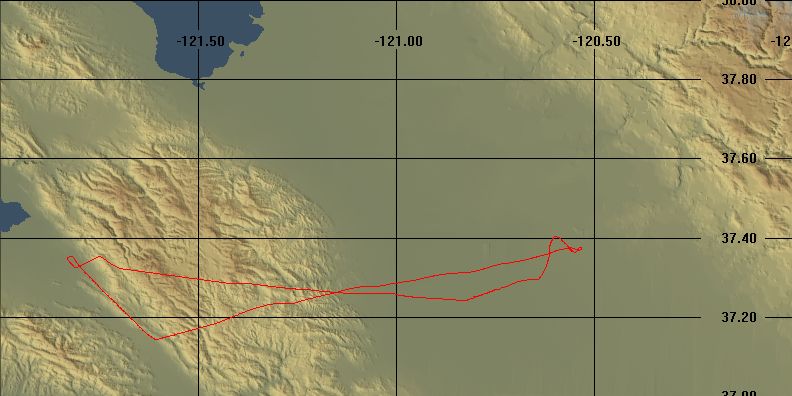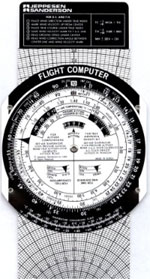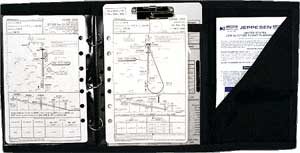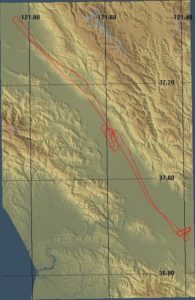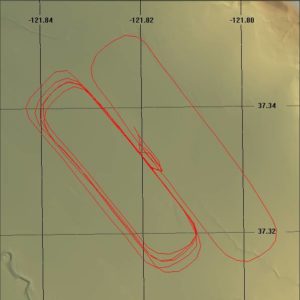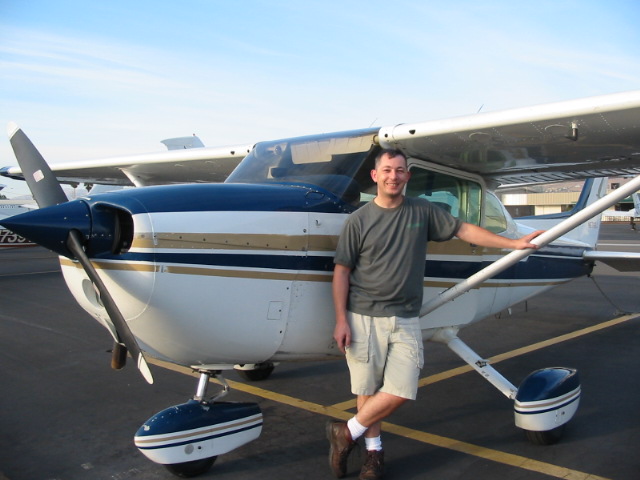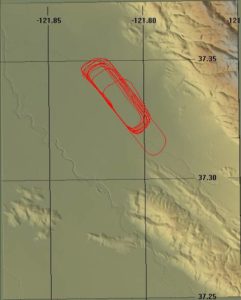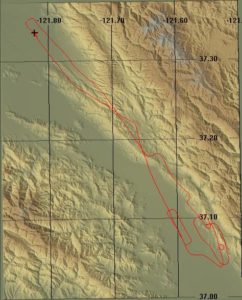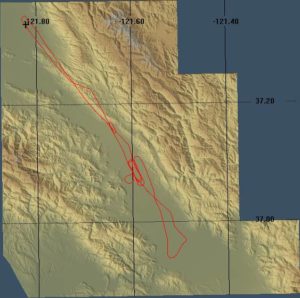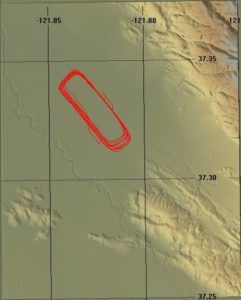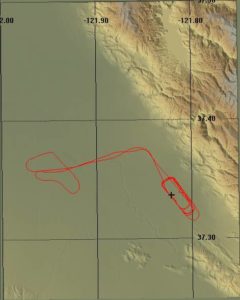 Today is my first night flight, I’ve already done a couple of full dark landings so I’m not too worried about it. However, its also my first trip into class C airspace which is a little more scary. It was almost dark when I arrived at the airport. The marine layer was already rolling in which is much earlier than usual. I was just reviewing San Jose Airport in the A/FD when Grainne showed up. We went over the radio procedures and the usual entries and exits we could expect for SJC. Basically RHV is so close to SJC, you tell RHV Ground Control you’re flying VFR to SJC and they get you a transponder code before you leave the ground. The pattern entry for runway 29 (the shortest runway in SJC, 4600′ long) is usually passing over mid field at 1500′ and then doing a descending turn onto the 45 for the downwind leg.
Today is my first night flight, I’ve already done a couple of full dark landings so I’m not too worried about it. However, its also my first trip into class C airspace which is a little more scary. It was almost dark when I arrived at the airport. The marine layer was already rolling in which is much earlier than usual. I was just reviewing San Jose Airport in the A/FD when Grainne showed up. We went over the radio procedures and the usual entries and exits we could expect for SJC. Basically RHV is so close to SJC, you tell RHV Ground Control you’re flying VFR to SJC and they get you a transponder code before you leave the ground. The pattern entry for runway 29 (the shortest runway in SJC, 4600′ long) is usually passing over mid field at 1500′ and then doing a descending turn onto the 45 for the downwind leg.
Did my first pre-flight in the dark with a flashlight, it took a bit longer but was otherwise OK. The panel lighting in 4754D is great, much better than 5766J (in fact now that I have the radio thing fixed, 54D is becoming my favorite plane). We had some fun with the radios, but this time it wasn’t us. It was the tower. When we tuned into Ground Control there was a really loud buzzing sound. Grainne called the tower and told them about it, at which time another plane chimed in said they had the same problem. So we were cleared to taxi down Zulu while the tower guys figured out there problem, helping them with various radio checks along the way. Finally about halfway down they got it working and thanked us for our help and then asked us what our departure request was. We told them and got a transponder code just before the run-up area. Had a normal run-up and did a straight out departure running along the east side of I-680 to stay out of class C.
We were cleared to change frequency to call SJC Tower just about the time I leveled off at 1500’. They asked for our altitude and for an IDENT on our transponder and then confirmed radar contact. As expected we were told to over fly the field at or above 1500’ and enter left downwind for runway 29. Right about this time I realized there was a cloud right off my right side and as I turned towards SJC we hit the bottom of the ceiling, I started descending and was at about 1400’ as we got close to the field. I was kind of worried about the clouds and being lower than instructed (though Grainne pointed out that the transponder was still showing 1500’ which is what the tower would see). In the confusion I was cleared to land as I passed over the center of the field, and I repeated back that clearance. I went out quite far beyond the field to make sure I had plenty of time to descend to pattern altitude and get established on the 45. A left 180 degree turn brought me in on the 45 at 1000’ and I turned downwind. It was kind of hard to make where the end of the runway was in order to judge the turn to base leg and of course this time I didn’t have any familiar ground references. Just about this time the Tower said, “Be advised traffic on final for the parallel runway is a Boeing 757”, this was pretty cool, I’m used to getting traffic alerts for rather smaller planes. The 757 was a lot easier to see than the usual Cessna’s and whatnot around the RHV traffic pattern. I made the turn from base to final early and angled onto the final approach trying to stay as far away as possible from the big iron landing on the runway next door. The final approach and landing went pretty well and Grainne called for a touch and go. As we climbed out the tower asked where we were and I said we had done a touch and go. At this point we realized that we only had a clearance for a landing not for the option (to do the touch and go). Tower asked us what we wanted to do, we decided that with the ceiling coming down fast at SJC and having just pissed the Tower guys off we’d better get out of Dodge, so we told them we would go back to RHV. They said, “make an immediate left turn and cross the field at 1500’”. Of course, the ceiling had dropped some more and I only got to about 1350’ before we hit the clouds. Grainne called the Tower and told them we could only maintain 1350’ crossing the field, they didn’t seem to mind and were probably just glad we were leaving before we screwed anything else up. A little passed the field they told us radar service was terminated, to squawk 1200 and contact RHV. So ended my first foray into class C airspace.
It took a couple of tries but the Tower at RHV finally answered and gave us the option of left or right traffic, I’d pretty much reached I-680 at this point so right traffic for 31R made the most sense. We did five landings and they were a lot of fun. The first was normal and went well. The second time around Grainne pulled the engine about mid downwind and I did a dead stick landing that worked great. Grainne’s only quibble was that I used 40 degrees of flaps to get down. I had shortened the downwind to make the final leg intentionally short and high. I wanted to land about a third of the way down the runway and I figured “altitude is options” so better high than low. As I was plenty high I needed all the flaps to get down. Grainne’s point was the plane is harder to control with full flaps and no engine, but at least I got down. On the third time around we were going to practice a forward slip. Grainne told me to take the engine to idle and pitch for 70 KIAS abeam the numbers. I’m not sure what she was intending. I extended the downwind a little, but of course we were descending faster than usual so we ended up on glide slope as I turned onto final (even without any flaps). So no need for a slip as it is used to lose unwanted altitude without gaining speed and we didn’t have any unwanted altitude at that point. Grainne had me do a no-flap landing instead, basically the same as a normal landing but the nose is pitched quite a bit higher. The landing was fine. The next time around there was a plane coming in on final approach so we had to extend our downwind a little bit anyway. I just kept at pattern altitude but slowed to about 70 KIAS on base. So of course we were high and long as we turned onto final – exactly what I wanted to practice the slip. For the first time I got into the forward slip, held the center line of the runway perfectly, lost exactly the altitude I wanted and exited without a flaw. It was great, I’ve had problems with this maneuver every time I’ve tried it until now. The actual landing went fine after than. On the last time through Grainne pulled the power again. This time I turned a little too early and ended up much higher than I wanted, I also resisted putting in the last 10 degrees of flaps so we were staring to run out of runway. Grainne said to pitch down for a speed of 80 KIAS to get down quicker. We got down with the end of the runway rather close to us, Grainne said “lets try to stop without running off the end”, I don’t know why she was worried, we stopped without problems and terminated for the night.
Tonight was a lot of fun. Landing at San Jose was a blast. Skimming along just under the clouds we cool and the landings as RHV went pretty well. Not just basics to get in the requirement for 10 night landings, but a chance to practice the dead-stick and slips as well. Next Thursday is scheduled for another solo flight but the weather looks iffy. On Saturday we’ll do the long cross country, we’re going to Pine Mountain Lake which is at just under 3000’ a little Northwest of Yosemite Valley.

